Functional API in Keras and TensorFlow
Overview
In this article, we will delve into the world of the Keras Functional API, a powerful tool for building complex neural networks in TensorFlow. While the Sequential API in Keras is intuitive for simple models, the Functional API provides greater flexibility and is ideal for constructing intricate architectures. We will explore the core concepts of the Functional API, demonstrating its versatility through various examples.
Understanding the Functional API
To comprehend the Functional API, we need to grasp its key attributes and how it differs from the Sequential API. The Functional API treats each layer as a function that takes input tensors and produces output tensors. By explicitly connecting these layers, we can form intricate neural network architectures, including multi-input and multi-output models, residual networks, and more. The explicit connections give us fine-grained control over data flow, making it easier to design custom models tailored to our specific needs.
Core Concepts of the Keras Functional API:
Input Tensors: The entry points of a Functional API model are the input tensors. By specifying the shape and data type of these tensors, we define the model's input layer.
Layers as Functions: In the Functional API, Keras layers become callable functions. Each layer accepts input tensors as arguments and returns the corresponding output tensors.
Connecting Layers: To create the network's architecture, we connect the output tensors of one layer to the input tensors of another. This establishes the flow of data through the model.
Model API: After defining the connections between layers, we create a Keras Model object using the Model API. This Model object serves as our final neural network, capable of both training and inference.
Creating Models with the Functional API
Creating models with the Functional API involves a series of steps that allow us to define complex architectures with multiple inputs, multiple outputs, shared layers, and more. Let's walk through the process of building a model using the Keras Functional API:
Building a Multi-Input Model
Let's use the Keras Functional API to construct a neural network that takes multiple inputs and merges them before making predictions. This type of architecture is common in applications such as multi-modal learning.
Output:
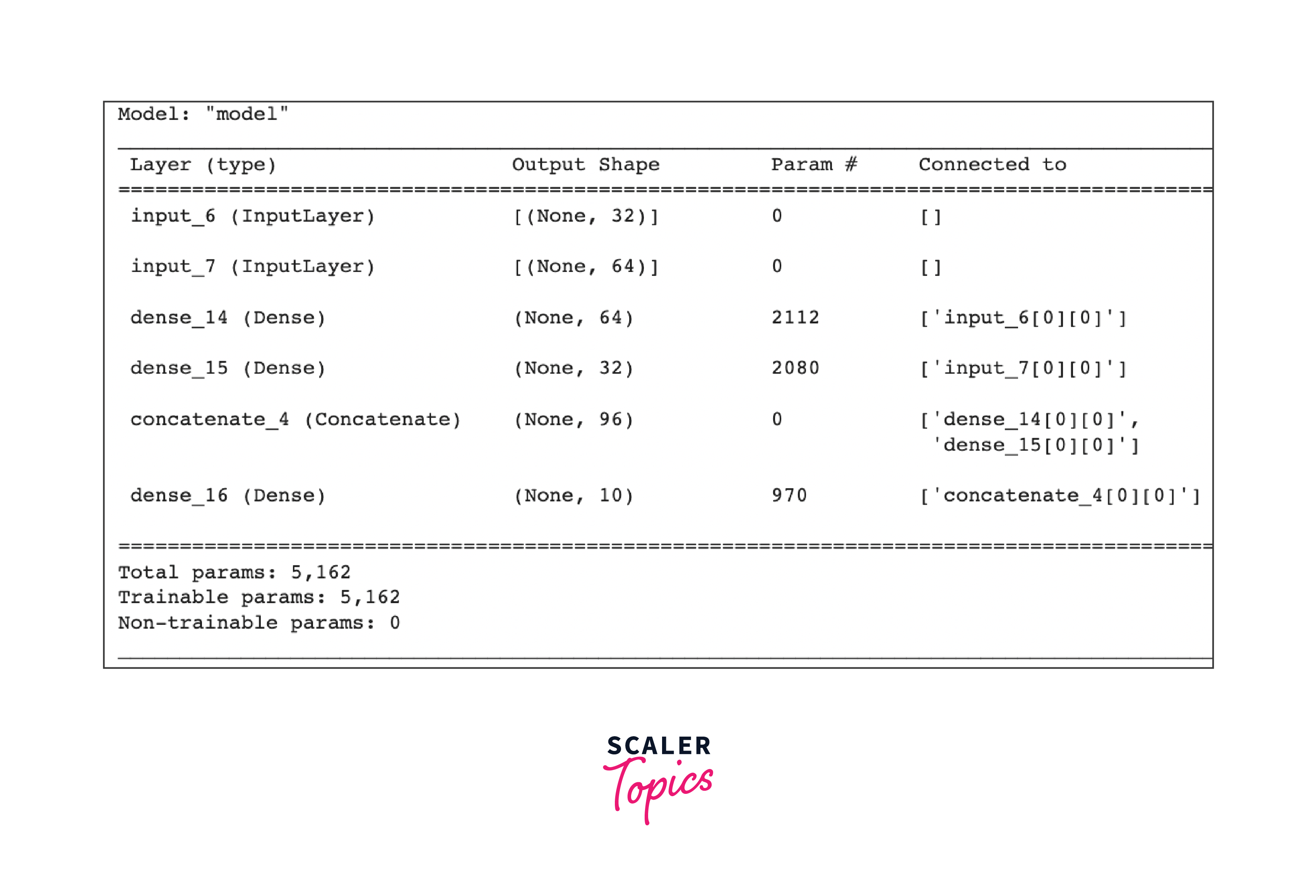
Implementing a Siamese Network
The Keras Functional API is exceptionally well-suited for Siamese networks, which learn the similarity between two inputs. These networks are often used in tasks like face recognition, signature verification, and similarity-based recommendation systems.
Output:
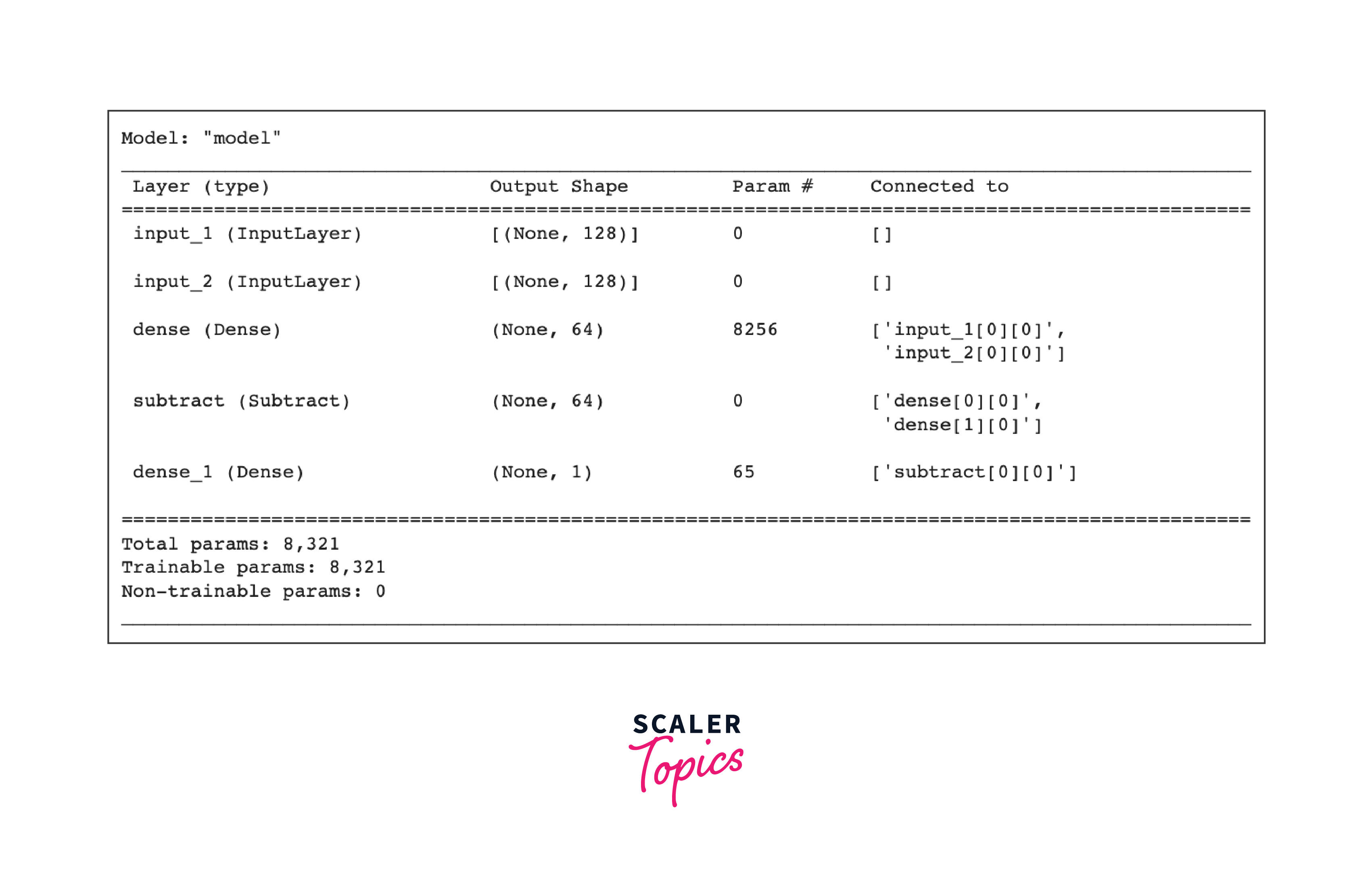
Functional API for Complex Model Architectures
The Keras Functional API provides a powerful and flexible way to build complex neural network architectures. Unlike the Sequential API, which constructs simple linear stacks of layers, the Functional API enables the creation of intricate and interconnected models. This is especially useful when dealing with models that have multiple inputs, multiple outputs, or shared layers. By explicitly defining the connections between layers, we can design custom architectures that cater to our specific needs.
With the Keras Functional API, we can create models with branches, skip connections, and more complex data flow patterns. This capability allows us to implement a wide range of deep learning architectures, including multi-modal networks, siamese networks, attention mechanisms, and residual networks, among others.
Functional API Vs. Sequential API
While the Sequential API in Keras is suitable for straightforward models where the data flows sequentially through the layers, it has limitations when it comes to more complex architectures. The Sequential API is ideal for single-input, single-output models, such as feedforward networks and simple CNNs. However, when we require models with multiple inputs or outputs, or when we need to create models with non-sequential connections, the Functional API is the way to go.
In the Functional API, each layer is treated as a function, accepting input tensors and producing output tensors. This allows for greater flexibility in connecting layers, enabling us to create non-linear data flow patterns and complex neural network structures. Moreover, with the Keras Functional API, we can build models that share layers, which is often beneficial for transfer learning and memory-efficient architectures.
Functional API in Advanced Use Cases
The Keras Functional API is an invaluable tool for implementing advanced deep learning architectures and tackling complex use cases. In this section, we'll explore some of the most notable advanced use cases where the Functional API excels:
Multi-Input and Multi-Output Models
The Functional API excels at handling models that have multiple inputs and outputs. For instance, in natural language processing tasks, we might have a model that takes both text and image inputs and produces two separate outputs, one for sentiment analysis and another for image classification. The Keras Functional API makes it straightforward to define and train such multi-input, multi-output models.
Let's implement this model in code using the Keras Functional API:
Output:
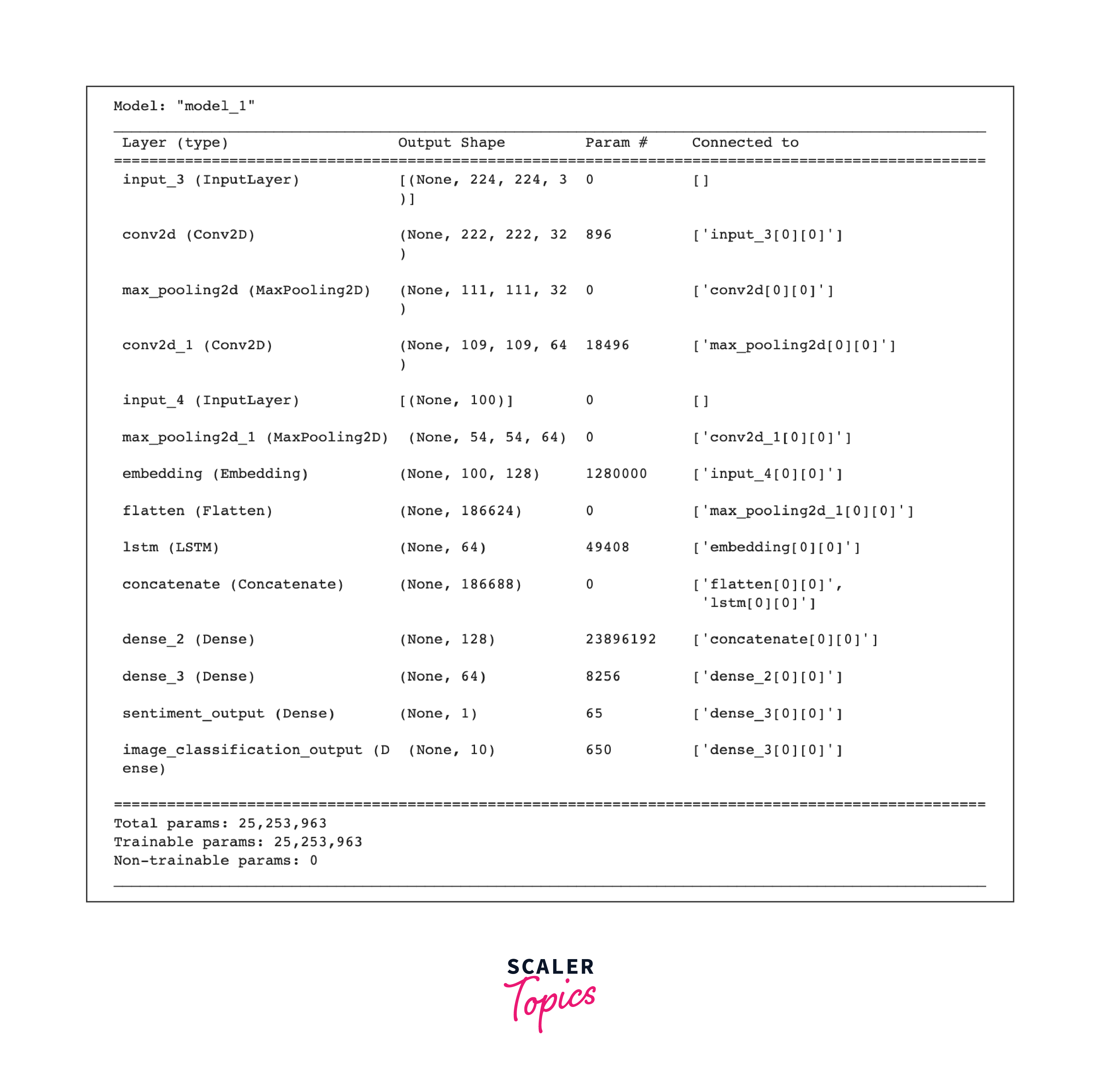
Here we have created a model with two separate outputs, one for sentiment analysis (binary classification) and another for image classification (multi-class classification). The image and text inputs are processed separately through convolutional and LSTM layers, respectively. After processing, the outputs are concatenated and passed through a series of dense layers before splitting into two final outputs.
Siamese Networks and One-Shot Learning
Siamese networks are designed to learn the similarity between two inputs. They are widely used in one-shot learning scenarios, where the model learns to recognize new classes with just a single training sample. The Keras functional API allows us to create Siamese architectures by sharing layers between two or more input branches, enabling efficient and effective learning of similarity metrics.
Residual Networks (ResNets)
Residual networks are a type of deep learning architecture that uses skip connections to enable the training of very deep neural networks. The skip connections help to address the vanishing gradient problem and make it easier for these networks to converge. With the Functional API, we can easily implement ResNets by adding skip connections that bypass one or more layers and merge with deeper layers in the network.
Training and Compiling Models with the Functional API
Training a model using the Keras Functional API is quite similar to training a model built with the Sequential API. After defining the model architecture, you compile the model with an optimizer, loss function(s), and metrics. Then, you use the fit method to train the model on your training data.
Output:
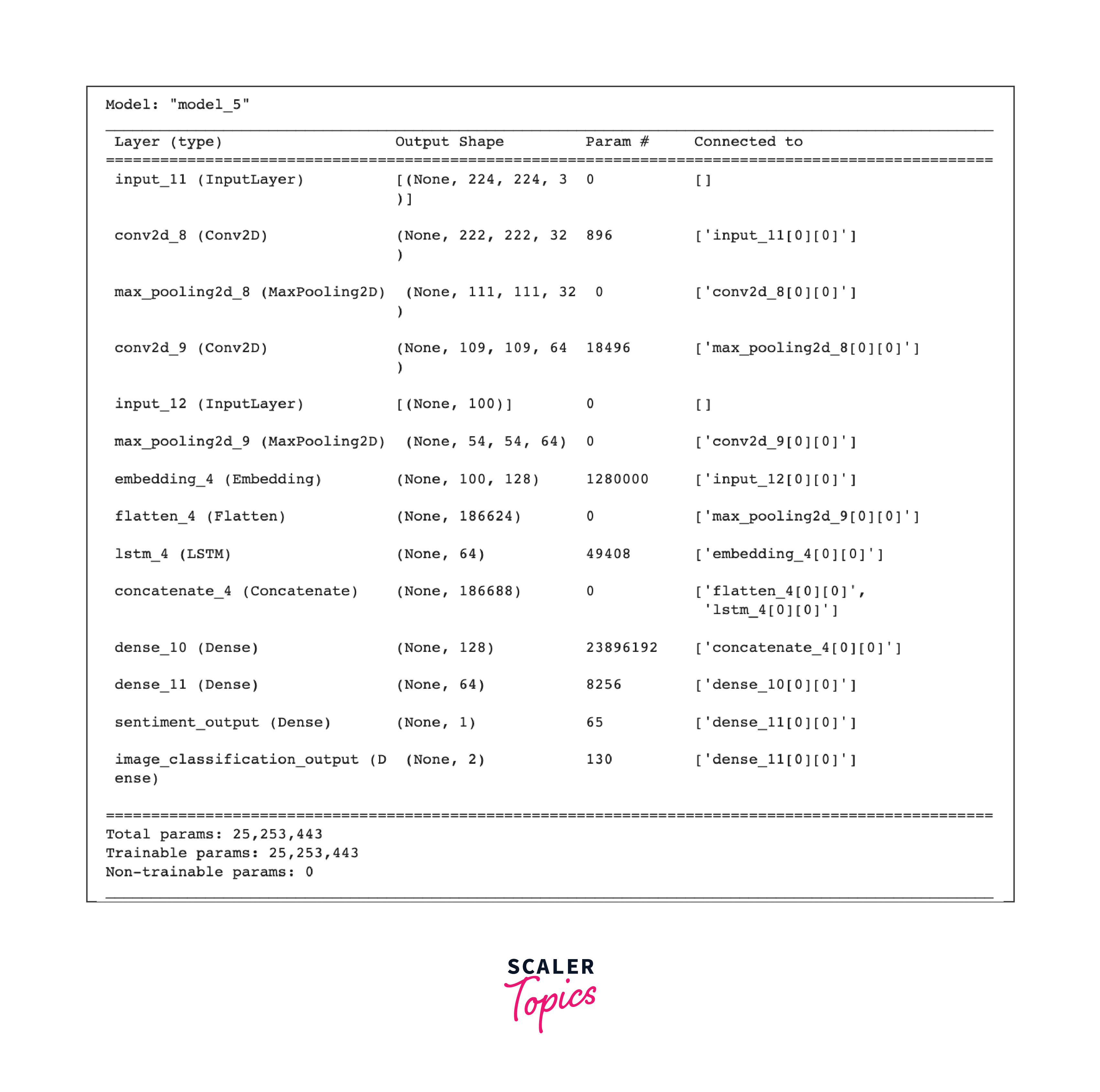
Serialization and Model Saving
After training a model, you can save it to disk for later use or deployment. The Keras Functional API allows you to easily save models using the save method and load them using the load_model function.
Model Visualization using the Functional API
The Keras Functional API also enables you to visualize your model's architecture using the plot_model function from the keras.utils.vis_utils module.
OUTPUT:
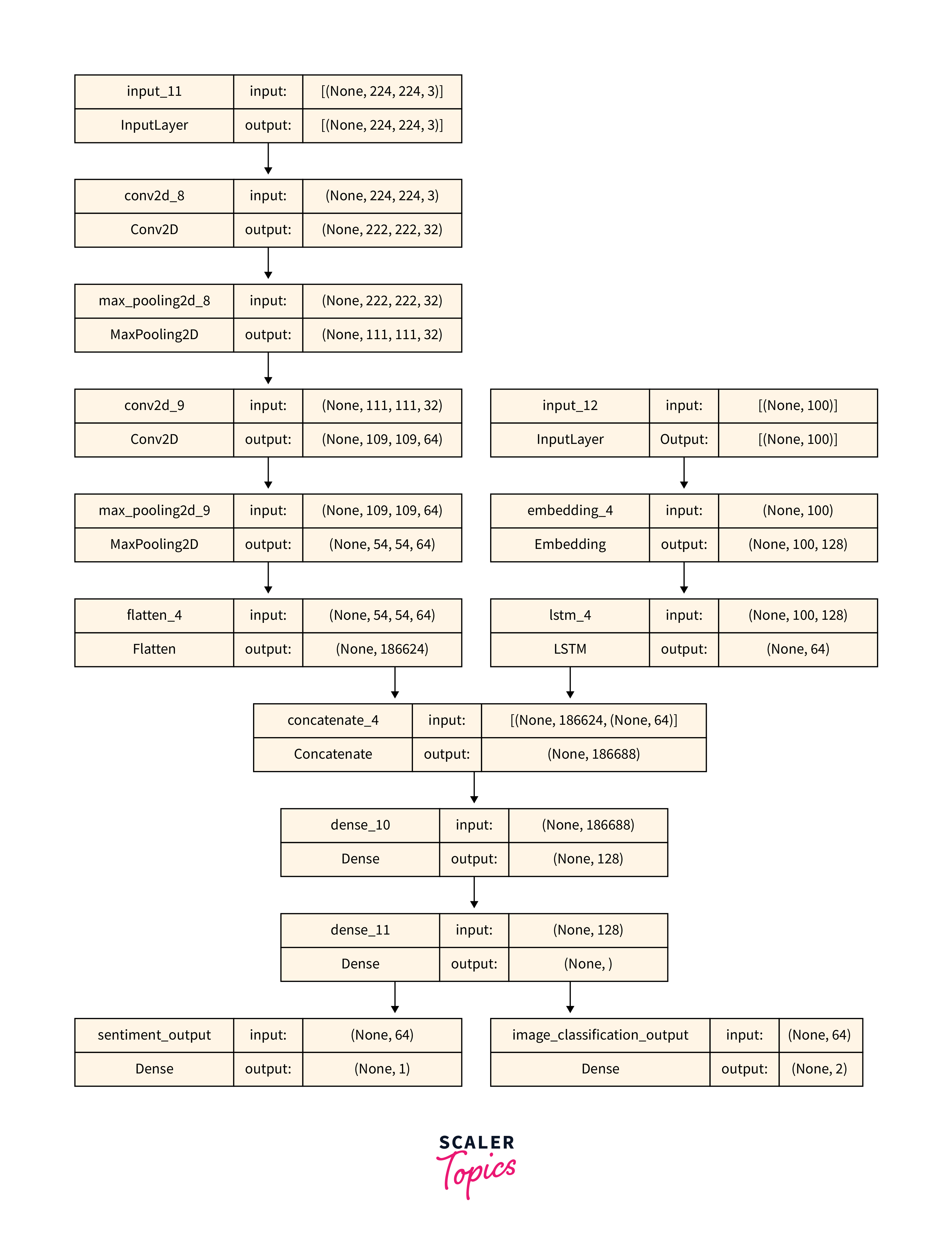
This function generates an image file ('multi_modal_model.png') that depicts the complete architecture of your model, including the connections between layers and the flow of data.
Benefits and Advantages of using the Functional API
1. Flexibility and Complex Architectures: The Functional API provides the flexibility to create complex model architectures, including multi-input, multi-output, and shared layers. This is crucial when dealing with advanced use cases in deep learning.
2. Customization: With the Functional API, you have fine-grained control over data flow and layer connections. This enables you to customize models for specific tasks and experiment with various configurations easily.
3. Reusability: The Functional API allows you to create and reuse shared layers across different parts of the model. This promotes code reusability and simplifies the implementation of complex architectures, such as Siamese networks or residual networks.
4. Debugging and Visualization: The explicit connections between layers in the Functional API make it easier to debug models. Additionally, the built-in model visualization tool ('plot_model') helps in understanding the model's structure visually.
5. Transfer Learning: Functional API enables seamless transfer learning by sharing layers between different models. This allows you to leverage pre-trained models and fine-tune them for specific tasks efficiently.
Conclusion
- Versatility and Flexibility: The Functional API in Keras and TensorFlow offers a versatile approach to building complex neural network architectures. It allows developers to create models with multiple inputs, multiple outputs, and shared layers, making it suitable for a wide range of advanced deep-learning applications.
- Customizable Architectures: Unlike the Sequential API, the Functional API enables fine-grained control over data flow and layer connections. This customization empowers researchers and practitioners to design models tailored to their specific tasks, such as siamese networks, attention mechanisms, and multi-modal learning.
- Multi-Input and Multi-Output Support: The Functional API excels in handling models that require multiple inputs or have multiple outputs. This capability is crucial for scenarios where neural networks process data from various sources, like combining images and text for joint predictions.
- Transfer Learning and Reusability: Functional API allows for seamless transfer learning by sharing layers between different models. This reusability of layers simplifies the implementation of complex architectures, fostering the use of pre-trained models and facilitating experimentation with novel architectures.
- Advanced Use Cases: The Functional API shines in tackling advanced deep learning tasks, including siamese networks for similarity learning, attention mechanisms for focused processing, generative adversarial networks (GANs) for generating new data, and residual networks (ResNets) for training very deep networks. Its ability to handle complex data flow patterns and connections makes it a preferred choice for cutting-edge research and applications.
